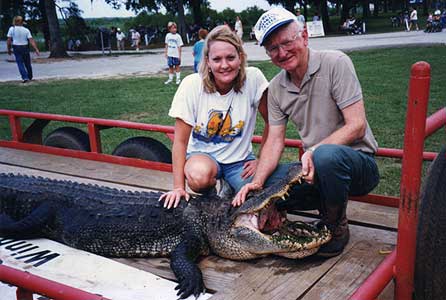
ALLIGATORS: CATCHERS AND CATCHEES
by Bob Jamison
Outdoor mysteries for the most expert and even amateur naturalist shouldn’t be a surprise at all. But wait a minute. While alligator hunting, something happened that should rank in the tops of outdoor life.
As an avid outdoorsman and conservationist, many things in the past are in the category of the unusual which have always fascinated me. Take for instance the amazing immune system of the lowly alligator. I observed a severely wounded alligator after it had a vicious fight with another alligator. This resulted in his right front leg being torn completely off. For months the cripple gator roamed the dark waters of a swamp in ninety degree heat. Yet, there was no infection whatsoever. New skin was grown leaving no scar in place of the missing limb.
Studies in England and even in some local universities have experimented with the blood serum of alligators and crocodiles and its effect on certain viruses. Out of seventeen viruses known to cause illness in humans, seven were stopped with human immune system qualities. The alligator serum stopped all seventeen. Side effects of alligator serum are currently unknown. Who knows, it could develop an Olympic swimmer.
Regardless, what is known about the alligator one thing is for sure; they have been around a long, long time. Prehistoric findings of giant alligators and their cousins have filled many interesting papers and books. However, our true native alligator is the American Alligator. This specimen is found only in America as a native reptile. Exotic species such as crocodiles and Cayman alligators have been introduced in Florida but they aren’t native to this country.
Strict regulations have protected this great animal for many years. In most recent years, their numbers have grown remarkably and they are no longer on the endangered list. In fact, there have been so many reports of dangerous alligators in residential lakes and even swimming pools that game departments reconsidered their protection. That is not to say that alligators don’t have protection. In fact there is a season to hunt alligators and a current $20 license tag per alligator is required if your application is accepted by the alligator program in the Texas Parks and Wildlife Department. Some wildlife management areas operated by the TP&WD allow applications for catching alligators. But before you plan to apply, do some careful counseling with an experienced alligator expert.
To catch a legal alligator you will find it is a combination of hunting, fishing and knowledge of its habitat. State biologist and alligator experts can advise one of public lands that might be available and explain duties for private habitat. But that’s not all.
There are several methods to catch alligators including bows and arrows. I can’t reasonably say I recommend this sport unless it is a very small alligator. Of course, I saw a person catch one with a fly rod only to release it. It was eight inches long.
But the one most commonly accepted is hook and line. Naturally, you should check current regs. A heavy salt water hook (not just a large fish hook) is recommended. It should be attached to a fifty foot line not less than 3/l6th inch. This line will normally be tied to a heavy but limber limb or an object that will secure a very strong pull. A fist size bait of liver, fish or chicken will work. The baited hook is placed about two feet above the water in proper alligator habitat. The alligator will leap up from the water and swallow the bait and become hooked. A well placed shot with buck shot just behind the eyes should cool off the rodeo activity. But be very careful. As most any reptile it can still bite.
To test an alligator’s habitat, careful observation of shore line slides is a must. They will often come out of the water to sun themselves. This leaves a slick muddy spot. They’ll likely frequent that spot.
What amazed me was this bright idea I had to use a game trail camera to catch an image of the alligator to make sure it was a large and one more dangerous than a five or six footer. It is designed to be placed on a trail to take pictures of most anything that moves by day or night. I have collected many interesting shots of deer, dogs, poachers and even a bird or two; so why not an alligator?
Upon opening of the season, I wired the camera to a tree four feet from the bait without a hook to see the size of the alligator. The next morning I was shocked to see the camera gone and so was the piece of chicken that had been suspended in front of the camera. Then I saw the tip of my camera floating in moss and duck weed about eight feet from where the bait had been hanging. Thankfully, the Moultrie Gamewatcher 2.1 digital camera had features for outdoor surveillance so it wasn’t harmed.
Quickly, I set up a TV monitor and reviewed the film. Sure enough in the dark of night the camera flash got a picture of an eight foot alligator. The next picture was a blur of a huge jaw and meaningful canine teeth. The alligator apparently smelled chicken on the camera from my handling both the bait and the camera. He tore it loose from the tree, decided it was not fit to eat and obviously spit it out. I have seen alligators up close before but never this close. In fact, in my imagination I truly believe I could detect the swampy smell of the alligator’s breath……. Now that is a true story proving the mysteries of the outdoors can never be underestimated.